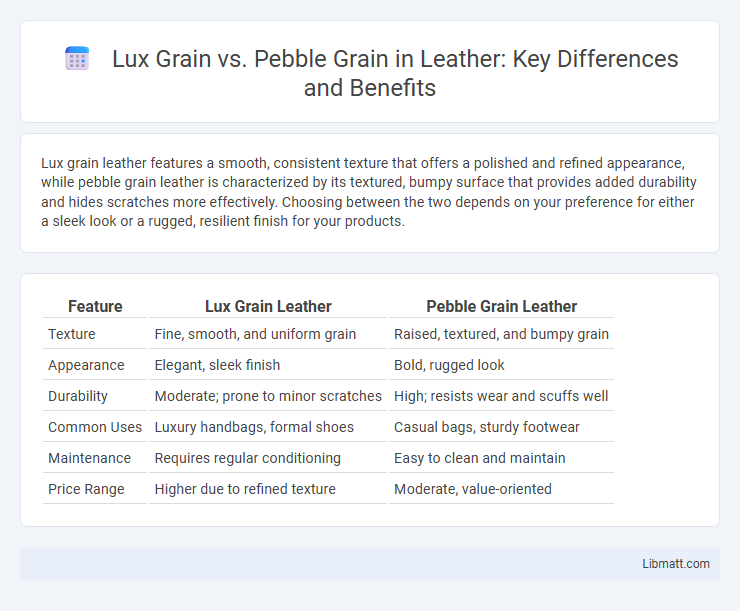Lux grain leather features a smooth, consistent texture that offers a polished and refined appearance, while pebble grain leather is characterized by its textured, bumpy surface that provides added durability and hides scratches more effectively. Choosing between the two depends on your preference for either a sleek look or a rugged, resilient finish for your products.
Table of Comparison
| Feature | Lux Grain Leather | Pebble Grain Leather |
|---|---|---|
| Texture | Fine, smooth, and uniform grain | Raised, textured, and bumpy grain |
| Appearance | Elegant, sleek finish | Bold, rugged look |
| Durability | Moderate; prone to minor scratches | High; resists wear and scuffs well |
| Common Uses | Luxury handbags, formal shoes | Casual bags, sturdy footwear |
| Maintenance | Requires regular conditioning | Easy to clean and maintain |
| Price Range | Higher due to refined texture | Moderate, value-oriented |
Introduction to Lux Grain and Pebble Grain
Lux Grain features a smooth, refined texture that enhances the elegance and softness of leather, making it ideal for high-end upholstery and fashion accessories. Pebble Grain, characterized by its raised, rounded texture resembling small pebbles, offers increased durability and resistance to wear, commonly used in luggage and durable leather goods. Your choice between Lux Grain and Pebble Grain depends on the desired aesthetic and functional requirements of your leather products.
Defining Lux Grain Leather
Lux grain leather features a finely textured surface with a subtle, natural-looking grain that enhances durability and aesthetic appeal. Pebble grain leather, in contrast, displays a coarser, more pronounced texture with rounded, pebble-like patterns that add ruggedness and grip. You can choose Lux grain leather for a sleek, sophisticated finish that combines elegance with resilience.
What is Pebble Grain Leather?
Pebble grain leather features a distinctive raised texture created by embossing the surface of the hide, providing enhanced durability and resistance to scratches compared to smooth leather types like Lux grain. This type of leather is commonly used in high-end accessories and upholstery due to its ability to maintain appearance over time while offering a tactile, luxurious feel. Understanding the characteristics of pebble grain leather helps you choose the best material for long-lasting, stylish products.
Key Differences Between Lux and Pebble Grain
Lux grain features a smooth, refined texture with a subtle sheen, offering a sophisticated and polished appearance ideal for luxury leather goods. Pebble grain, characterized by its raised, rounded bumps and pronounced texture, provides enhanced durability and resistance to scratches, making it suitable for everyday use. The key differences lie in their texture, aesthetic appeal, and functional properties, with Lux grain emphasizing elegance and Pebble grain prioritizing toughness.
Appearance and Texture Comparison
Lux grain leather features a smooth, refined surface with subtle natural markings, offering a sleek and elegant appearance ideal for sophisticated leather goods. Pebble grain leather displays a pronounced, textured pattern of small rounded bumps, providing enhanced durability and a distinctive tactile feel that resists scratches better. Your choice between these grains depends on whether you prefer a polished look with gentle texture or a rugged, visibly textured finish.
Durability and Longevity
Lux grain exhibits superior durability due to its tightly woven texture that resists scratches and scuffs, ensuring extended longevity in high-use scenarios. Pebble grain offers moderate durability with a textured surface that masks minor wear but may show aging signs faster than Lux grain over time. Your choice between Lux and pebble grain impacts how well the material withstands daily abrasion and maintains its appearance for years.
Luxury and Brand Associations
Lux grain leather is renowned for its smooth, refined texture that exudes sophistication, making it a preferred choice among luxury brands seeking to convey exclusivity and high-quality craftsmanship. Pebble grain, characterized by its textured, durable surface, is often associated with brands emphasizing rugged elegance and practicality without sacrificing premium appeal. Both grain types enhance brand identity by signaling distinct facets of luxury--Lux grain highlights sleek opulence, while pebble grain reflects understated luxury with resilience.
Care and Maintenance Requirements
Lux grain leather requires gentle cleaning with a damp cloth and occasional conditioning to maintain its smooth surface and prevent drying, while pebble grain leather is more durable and resistant to scratches, needing less frequent maintenance. Your care routine should involve avoiding harsh chemicals for both types, but pebble grain's textured surface can better hide wear and is easier to clean. Regularly applying a suitable leather conditioner will prolong the lifespan of both lux grain and pebble grain leathers.
Pricing and Value Considerations
Lux grain leather generally commands a higher price due to its refined texture and premium craftsmanship, offering superior durability and a luxurious finish that enhances long-term value. Pebble grain leather tends to be more affordable, providing a rugged and textured appearance that is resistant to scratches and ideal for casual or everyday use. Buyers seeking a balance between cost and aesthetics should evaluate the intended application and longevity to determine the best value.
Choosing Between Lux Grain and Pebble Grain
Choosing between Lux grain and pebble grain depends on the desired leather texture and durability. Lux grain offers a smooth, refined finish ideal for elegant accessories, while pebble grain features a textured surface that enhances grip and resists scratches. Your decision should balance aesthetic preference with practical use to match your lifestyle and product needs.
Lux grain vs pebble grain Infographic

 libmatt.com
libmatt.com